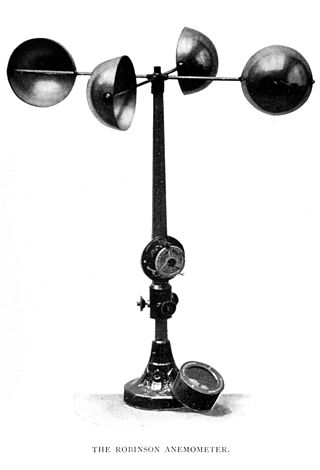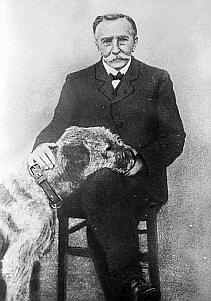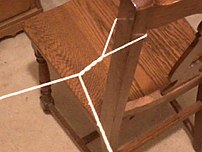
Acoustics is a branch of physics that deals with the study of mechanical waves in gases, liquids, and solids including topics such as vibration, sound, ultrasound and infrasound. A scientist who works in the field of acoustics is an acoustician while someone working in the field of acoustics technology may be called an acoustical engineer. The application of acoustics is present in almost all aspects of modern society with the most obvious being the audio and noise control industries.

In meteorology, an anemometer is a device that measures wind speed and direction. It is a common instrument used in weather stations. The earliest known description of an anemometer was by Italian architect and author Leon Battista Alberti (1404–1472) in 1450.

A telephone, colloquially referred to as a phone, is a telecommunications device that permits two or more users to conduct a conversation when they are too far apart to be easily heard directly. A telephone converts sound, typically and most efficiently the human voice, into electronic signals that are transmitted via cables and other communication channels to another telephone which reproduces the sound to the receiving user. The term is derived from Ancient Greek: τῆλε, romanized: tēle, lit. 'far' and φωνή, together meaning distant voice.

In telecommunications, an acoustic coupler is an interface device for coupling electrical signals by acoustical means—usually into and out of a telephone.

Robert Hooke was an English polymath who was active as a physicist, astronomer, geologist, meteorologist and architect. He is credited as one of the first scientists to investigate living things at microscopic scale in 1665, using a compound microscope that he designed. Hooke was an impoverished scientific inquirer in young adulthood who went on to became one of the most important scientists of his time. After the Great Fire of London in 1666, Hooke attained wealth and esteem by performing more than half of the property line surveys and assisting with the city's rapid reconstruction. Often vilified by writers in the centuries after his death, his reputation was restored at the end of the twentieth century and he has been called "England's Leonardo [da Vinci]".

A microphone, colloquially called a mic, or mike, is a transducer that converts sound into an electrical signal. Microphones are used in many applications such as telephones, hearing aids, public address systems for concert halls and public events, motion picture production, live and recorded audio engineering, sound recording, two-way radios, megaphones, and radio and television broadcasting. They are also used in computers and other electronic devices, such as mobile phones, for recording sounds, speech recognition, VoIP, and other purposes, such as ultrasonic sensors or knock sensors.

Johann Philipp Reis was a self-taught German scientist and inventor. In 1861, he constructed the first make-and-break telephone, today called the Reis telephone. It was the first device to transmit a voice via electronic signals and for that the first modern telephone. Reis also coined the term.

The telautograph is an ancestor of the modern fax machine. It transmits electrical signals representing the position of a pen or tracer at the sending station to repeating mechanisms attached to a pen at the receiving station, thus reproducing at the receiving station a drawing, writing, or signature made by the sender. It was the first such device to transmit drawings to a stationary sheet of paper; previous inventions in Europe had used a constantly moving strip of paper to make such transmissions and the pen could not be lifted between words. Surprisingly, at least from a modern perspective, some early telautographs used digital/pulse-based transmission while later more successful devices reverted to analog signaling.

Antonio Santi Giuseppe Meucci was an Italian inventor and an associate of Giuseppe Garibaldi, a major political figure in the history of Italy. Meucci is best known for developing a voice-communication apparatus that several sources credit as the first telephone.

Nathan Beverly Stubblefield was an American inventor best known for his wireless telephone work. Self-described as a "practical farmer, fruit grower and electrician", he received widespread attention in early 1902 when he gave a series of public demonstrations of a battery-operated wireless telephone, which could be transported to different locations and used on mobile platforms such as boats. While this initial design employed conduction, in 1908 he received a U.S. patent for a wireless telephone system that used magnetic induction. However, he was ultimately unsuccessful in commercializing his inventions. He later went into seclusion, and died alone in 1928.

This timeline of the telephone covers landline, radio, and cellular telephony technologies and provides many important dates in the history of the telephone.
The Reis telephone was an invention named after Philipp Reis of a telephone-like device he constructed. Reis's first successful work is dated to October 1861. It was the first device to transmit a voice via electronic signals and for that the first modern telephone. Reis also coined the term.

A security alarm is a system designed to detect intrusions, such as unauthorized entry, into a building or other areas, such as a home or school. Security alarms protect against burglary (theft) or property damage, as well as against intruders. Examples include personal systems, neighborhood security alerts, car alarms, and prison alarms.

A pickup is a transducer that captures or senses mechanical vibrations produced by musical instruments, particularly stringed instruments such as the electric guitar, and converts these to an electrical signal that is amplified using an instrument amplifier to produce musical sounds through a loudspeaker in a speaker enclosure. The signal from a pickup can also be recorded directly.

The invention of the telephone was the culmination of work done by more than one individual, and led to an array of lawsuits relating to the patent claims of several individuals and numerous companies. Notable people including in this were Antonio Meucci, Philipp Reis, Elisha Gray and Alexander Graham Bell.

The carbon microphone, also known as carbon button microphone, button microphone, or carbon transmitter, is a type of microphone, a transducer that converts sound to an electrical audio signal. It consists of two metal plates separated by granules of carbon. One plate is very thin and faces toward the speaking person, acting as a diaphragm. Sound waves striking the diaphragm cause it to vibrate, exerting a varying pressure on the granules, which in turn changes the electrical resistance between the plates. Higher pressure lowers the resistance as the granules are pushed closer together. A steady direct current is passed between the plates through the granules. The varying resistance results in a modulation of the current, creating a varying electric current that reproduces the varying pressure of the sound wave. In telephony, this undulating current is directly passed through the telephone wires to the central office. In public address systems it is amplified by an audio amplifier. The frequency response of most carbon microphones, however, is limited to a narrow range, and the device produces significant electrical noise.

This history of the telephone chronicles the development of the electrical telephone, and includes a brief overview of its predecessors. The first telephone patent was granted to Alexander Graham Bell in 1869.
Acoustic quieting is the process of making machinery quieter by damping vibrations to prevent them from reaching an observer. Machinery vibrates, causing sound waves in air, hydroacoustic waves in water, and mechanical stresses in solid matter. Quieting is achieved by absorbing the vibrational energy or minimizing the source of the vibration. It may also be redirected away from an observer.

A mechanical filter is a signal processing filter usually used in place of an electronic filter at radio frequencies. Its purpose is the same as that of a normal electronic filter: to pass a range of signal frequencies, but to block others. The filter acts on mechanical vibrations which are the analogue of the electrical signal. At the input and output of the filter, transducers convert the electrical signal into, and then back from, these mechanical vibrations.

Electric music technology refers to musical instruments and recording devices that use electrical circuits, which are often combined with mechanical technologies. Examples of electric musical instruments include the electro-mechanical electric piano, the electric guitar, the electro-mechanical Hammond organ and the electric bass. All of these electric instruments do not produce a sound that is audible by the performer or audience in a performance setting unless they are connected to instrument amplifiers and loudspeaker cabinets, which made them sound loud enough for performers and the audience to hear. Amplifiers and loudspeakers are separate from the instrument in the case of the electric guitar, electric bass and some electric organs and most electric pianos. Some electric organs and electric pianos include the amplifier and speaker cabinet within the main housing for the instrument.




















